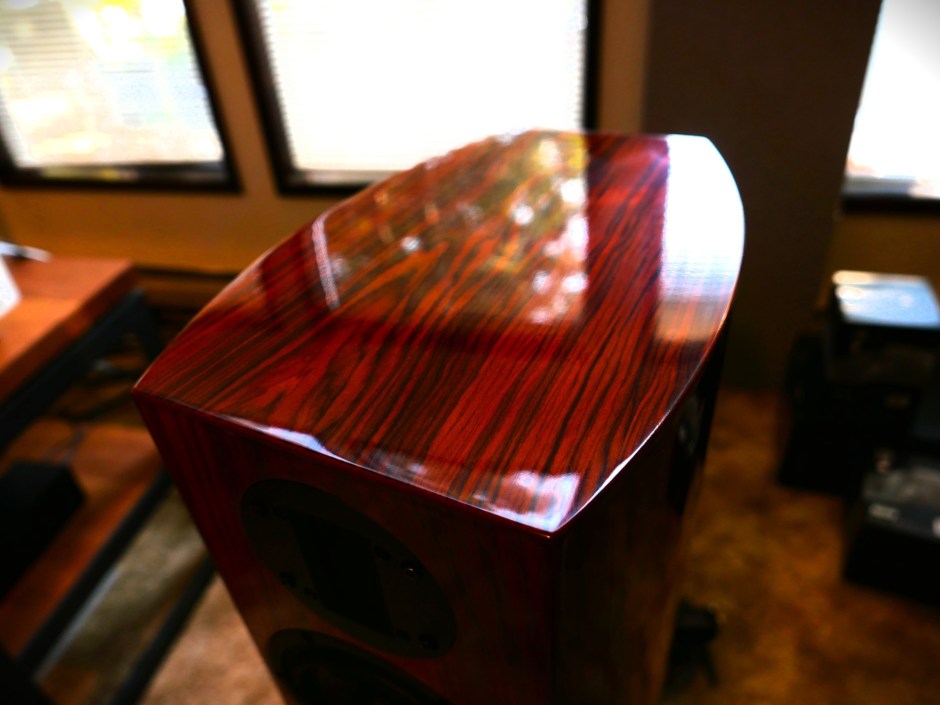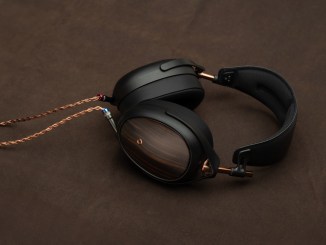We’ve reviewed plenty of gear from the Underwood HiFi umbrella of brands over the last year, everything from the Audio-gd Master 10 Mk. II integrated amplifier that was a nominee for Best Value of the Year in 2023 to the Emerald Physics 600.2SE power amplifier that, well, was also a Best Value of the Year nominee, to the LSA Signature 80 loudspeakers that impressed the heck out of John Richardson. I’ve reviewed several of Underwood HiFi’s brands–the aforementioned Audio-gd, Core Power Technologies and even the LSA T-3 turntable–but I’ve never reviewed an LSA speaker until now. That’s why I jumped at the chance to review the LSA Statement 100 monitors–it’s their flagship two-way monitor, and you know how I feel about those.
Words and Photos by Marc Phillips
Honestly, I’ve tried to listen to LSA speakers before–I even put myself in line for a pair of their little sub-$1,000 speakers just to get a feel for the sound, and how they do so much for so little money. (This was during the early days of the pandemic, when worldwide shipping was chaotic at best.) In addition, I’m always impressed with the looks of these LSA speakers–the fit and finish is always superb, and at the very least they photograph extremely well. With these LSA Statement 100 monitors, however, I’m very impressed with the build quality–rounded and graceful cabinets, a beautiful and glossy rosewood finish, a high-quality ribbon tweeter and even a passive bass radiator on the rear.
In typical Underwood HiFi fashion, the LSA Statement 100 monitors are strong values at just $2,995/pr. (Also in typical Underwood fashion, they are currently offered at an introductory price of just $2,499/pair delivered.) I can start off by telling you that the 100s certainly belong in the same class as many of the expensive stand-mounts I’ve had in my system over the last few months, some that cost twice as much or more. But Underwood Wally wants his consistently superb products to be considered as “good” instead of “good for the money.” After reviewing the Audio-gd integrated, I get it. That was such a superb amp in so many ways that thinking about its modest MSRP served as nothing more than a distraction.
So it’s time to evaluate the LSA Statement 100 monitors the same way–I’m not going to mention the price again because it doesn’t really matter. If you’re the type of audiophile who won’t consider something because it seems too affordable, you’re not in this hobby for you. You’re in it to impress other audiophiles. This speaker is for music lovers, who tend to be very smart buyers.
Inside the LSA Statement 100 Monitors
The core philosophy of the LSA Statement 100 monitors is focused on the quality of the drivers and the crossover, which seems like common priorities for a designer. Here’s how the Underwood HiFi website summarizes the monitor:
“The speakers use our custom 6.5″ XBL/2 metal cone woofer along with a rear mounted 5×7 sub bass radiator and a very high quality true ribbon tweeter. The woofer uses a dual magnet design to allow approximately double the linear throw of a standard 6/.5 in driver. Bass output is therefore equivalent to two 6.5″ woofers. The are housed in a gorgeous Rosewood enclosure. Upgraded internal wire and copper binding posts finish the package.”
The LSA Statement 100 monitors are fairly easy to drive–they’re 87 dB efficient with an 8-ohm impedance. The recommended minimum power is 25 wpc, which feels about right since I matched them with my Naim NAIT 50 integrated amplifier and had no problem with dynamics, bass response or ultimate SPLs. The Allnic Audio T-1500 Mk. II integrated, with its 300B output tubes and its 10 watts per channel, ran out of juice in my larger listening room, but at the same time I felt the combination would work just fine in a smaller room, like the one I had back in Portland. (As we SET fans sometime say, you never know until you try.)
The frequency response for the LSA Statement 100s are also impressive, with an in-room response of 32Hz to 30 kHz +/-3dB. As you’ll find out shortly, the 100s really shine when it comes to energizing large rooms with plenty of bass information.
Set-Up
I tested the LSA Statement 100 in two different systems during their stay at the lake house. The first system I used both the Naim NAIT 50 (25 wpc) and the Audio Note UK Cobra integrated amp/DAC (28 wpc). The second system had a bit more power on tap, thanks to the Electrocompaniet ECI 6 Mk. II integrated amp/DAC/streamer and its 125 wpc (into 8 ohms).
I tried several speaker cables with the LSA Statement 100 monitors from Furutech, ArgentPur, AudioQuest and MonAcoustic, but I felt I had the best overall results with the Ansuz D2. With the D2s, the 100s suddenly bragged about their incredibly large soundstage, and the very satisfying low frequencies and overall balance were smooth and natural. I used the Acora Acoustics SRS-G speaker stands, which helped to reinforce that feeling of coherence, especially in the upper bass and midrange.
Room placement was simple and straightforward. The LSA Statement 100 loved my “default setting” for two-way monitors, with modest toe-in and plenty space from back and side walls. One of the remarkable things about this speaker was its ability to preserve a consistency in the bass–while it obviously changed in size and depth as you moved the speakers around the room, the character of those low frequencies did not change. Textures and layers and colors remained despite the SPLs.
LSA Statement 100 Sound
I’ve mentioned the bass performance of the LSA Statement 100 monitors already, but I’ll tell you what impressed me even more on first listen–the size of the soundstage. The depth, first of all, was stunning and the soundstage seemed to jumped through the picture windows behind them and out onto the lake for a quick sail. While that enormous depth seemed to pull the front edge of the soundstage away from the listening position, it wasn’t an issue. The 100s are speakers that simply sound relaxed and laid-back, and illusion that usually pops up when you have the depth. But I was also pleased with the soundstage width, which seemed to flank me completely on a number of occasions with truly excellent source material.
The tonality of the LSA Statement 100s is a little on the soft and warm side (in this household, that’s a good thing), and while these speakers didn’t quite mesh with the Allnic Audio T-1500 Mk. II 300B amp, I found that they still reminded me of the 300B sound on their own. There’s a roundness and smoothness to the presentation, coupled with that undeniable and musical warmth, that’s quite seductive. As I mentioned in the review of the Alexandra Audio The Monitor loudspeakers, the Statement 100s with the Electrocompaniet consistently reminded me of how the Allnic and the Alexandrias sounded together. I hate to keep beating the “warmth with all the detail” drum, but that’s what makes me happy.
Listening Sessions
Despite the truly superb bass on the LSA Statement 100 monitors, I didn’t race to listen to demo tracks such as “Chocolate Chip Trip” and “Yulunga.” These speakers have a refinement to them that almost demands softer and more intimate music to uncover their potential. I started off with Blicher Hemmer Gadd’s It Will Be Alright, which is legendary drummer Steve Gadd’s jazz organ trio with Michael Blicher on sax and Dan Hemmer on the Hammond B3. Yes, it’s as fun as it sounds.
I’ve listened to a few of Gadd’s more recent albums, and if you’re hoping for 40 minutes of explosive “Aja” solos you’re in the wrong jazz club. Stevie Gadd, as my friend Dr. Vinyl calls him, is one of those drummers who, like Mick Fleetwood and Jim Keltner, are known for being exquisite timekeepers. (We used to call them drummer’s drummers.) The joy of Gadd, however, is in hearing his control over his kit, and how he can still keep flawless time while introducing new packages of sounds that evolve throughout the length of the track. But there are a few moments during this album when Gadd starts to rough-house with his kick drum, and it’s amazing how much is going on in the same time–weight, power and accuracy with incredible decay and bloom. The LSA Statement 100s collected all of that information and truly made it exciting. I might not have noticed these passages at all with another speaker.
With harpist/singer Margot Sergent’s Douce France, from Zoho Music, the LSA Statement 100 monitors proved their worth in terms of uncovering subtle bits of information from a complex musical instrument. I’ll admit that the harp makes even mediocre hi-fi systems sound pretty darned good, but it takes a highly resolving system to uncover the low-frequency energy this instrument can conjure. The 100s allowed me to hear everything in her playing, from her poised fingers resting on the strings to the movement of her arms through air.
Finally, I listened to the latest 2L Recordings release, Borders from composer Henning Sommerro, performed by the Trondheim Symphony Orchestra. This isn’t a small, intimate recording like the others, and I wanted to hear how the LSAs could handle a larger and more dynamic piece. The answer, of course, is of course it can. The deep soundstage was essential to organizing the sound of an orchestra in yet another cavernous Norwegian church, and that laid-back quality of the 100s delivered when it came to defining the boundaries of the recording space. Not every stellar two-way monitor meets the basic requirements to deliver the complete and unfettered whole of a 2L Recording, but the LSA Statement 100s did. Easily.
LSA Signature 100 Conclusions
As I’m writing this review, I suddenly regret that I wasn’t able to hear the LSA Statement 100 monitors with that Audio-gd Master 10 Mk. II integrated. Once again, they were ships that passed in the night. Since I’m equally impressed by both of these products in the Underwood HiFi stable, I can’t help but wonder if this is the core of a magical hi-fi system for those who can’t afford speakers that cost more than a new car.
That’s not the point here, and neither is the cost. The LSA Statement 100 monitors have everything going for them–they look gorgeous, they sound soft and beautiful, and they throw out a surprisingly big soundstage with plenty of deep bass, even in a fairly large room. Wally says that if you close your eyes, the 100s should sound like a big floor-standing speaker and they do, within reason. I will admit that their soft, smooth and gentle demeanor, even with those low frequency reserves, may exclude audiophiles who think they crave neutrality and shy away from a speaker that can drop you off at the front entrance of Total Relaxation.
But I think that most audiophiles, without any prompting about price or manufacturer, are going to listen to this speaker and just declare yes, I really like these. I really did, and that’s why I recommend them.













I’ve been a long time LSA speaker fan, starting with their LSA 1 Statement (folded ribbon), their LSA 10 Statement (beryllium), and moving several months ago to the Statement 100 reviewed above.
The leap from 1 to 10 was extraordinary. Going from 10 to 100 was more subtle at first, but you instantly understand that the 100s are a better blended and smoother speaker. Once the speakers are settled in, positioned correctly (slightly more directional than the 10s domes), and the drivers nice and broken in, they are phenomenal.
I have a very large room (25x30x20H) open on 3 walls to other spaces, and these little 100s and a REL S/510 will flat out rock! I’m using Audio by Van Alstine DVA M750 Monoblocks (750W Class A/A-B) fed by a Lampizator TRP 3 tube DAC, and these little speakers love it loud. Intimate jazz is astounding, acoustic guitar is liquid gold, female voices are in the room, drums and cymbals are textured and have great sustain, and everything from pop to dance to samba to metal to atmospheric sounds superb.
Monstrous wrap-around soundstage, crystal clear, and even toned across the audio spectrum. Just fantastic little speakers.
Huge fan of Wally’s dedication to advancing the quality of sound (in my home) over the last 12-ish years!